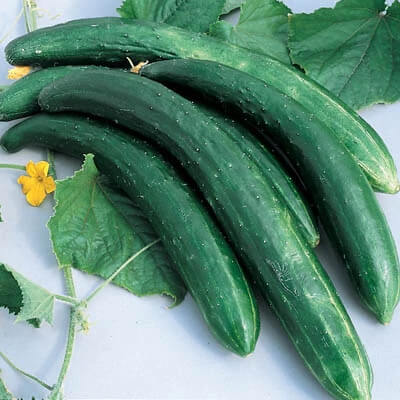You can’t make a decent salad without the fresh, crisp bite of cucumber. Don’t settle for the overgrown store-bought cucumbers when you can learn how to grow cucumbers at home, and harvest fresher, firmer, tastier fruits for a surprisingly long season.
Cucumbers need heat to germinate, and plenty of water, so you’ll need a decent irrigation set up, or some water butts to keep growing costs down, and really good compost packed with nitrogen to get them started in early summer.
If you get that right, you’ll be harvesting kilos of these firm green fruits right through summer, even into early autumn.
More...
Family: | Cucurbitaceae |
|---|---|
Genus: | Cucumis |
Species: | C. sativus |
Common Names: | Cucumber, Gherkin |
Location: | Outdoor |
Type: | Annual vegetable |
Growth: | 1-2m height or spread |
Sun requirements: | Full sun to partial shade |
Foliage Colour: | Green |
Flower Colour: | Yellow |
Flowering: | Summer |
Fruit: | Edible green berries |
Maintenance level: | Low |
Poisonous for pets: | Non-toxic to cats and dogs |
Getting to Know Cucumbers
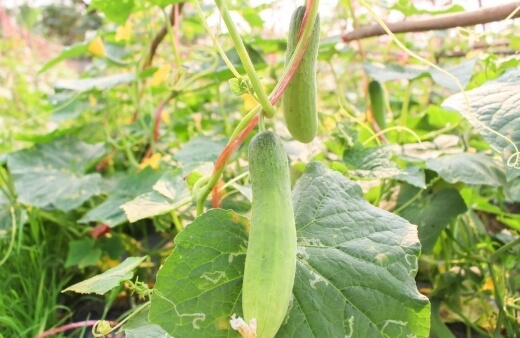
Cucumbers are the elongated berries of Cucumis sativus, a species that included cucumbers, gherkins and some more unusual varieties like cucamelons too.
Their thin skins fill with water in late summer, following pollination between plants, with a thick layer of crisp, pale green, watery flesh that is packed with a grassy, melon-like flavour that screams of summer.
There are quite a few different types of cucumber, and some unusual hybrids between them and other members of the Cucurbitaceae family (which included rockmelons, courgettes, pumpkins, squashes and gourds) and each has different growing requirements.
Here, we like to grow all cucumbers up trellis, but that can take a little extra work so read on to find out about different ways to grow cucumbers in small spaces.
Cucumber’s Natural Habitat
Cucumbers are native to India, where they enjoy high temperatures, good humidity and irregular (but heavy) rainfall. While cucumbers are naturally occurring, they have been cultivated as a crop in India for over 3000 years, with preserved stores found in cave excavations.
While they are native to India they have naturalised in most temperate climates and have been widely cultivated globally since the early 15th century, with Christopher Columbus being responsible for introducing them to Haiti and the New World in 1494.
Different Types of Cucumbers
While modern hybrid cucumbers are a little more nuanced, there are four traditional categories that help us to group cucumbers by their growing habits, flavour, and fruit:
- Burpless
- Gherkin
- Slicing
- Pickling
Types of Cucumber Fruits
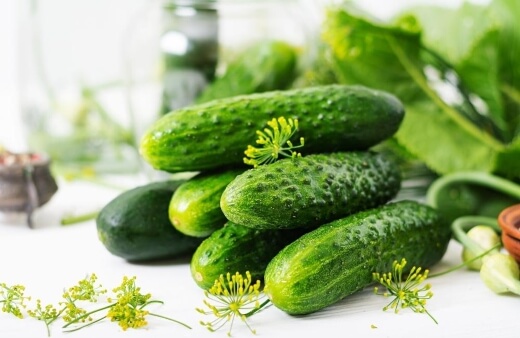
Burpless cucumbers
This type contain lower concentrations of the cucurbitacin compound, which causes bitterness. Cucumbers disagree with many people and cause gassiness and burping due to the biochemical compound, cucurbitacin.
Burpless cucumbers have had most of that compound bred out of them, and are great eaten raw, with a sweeter, milder flavour.
Gherkins
Gherkins are smaller cucumbers, ideal for snacking and pickling. They contain less water in their centres, and their firm texture makes them perfect for salads.
If cucumbers do make you burp, then definitely pickle your gherkins as this reduces the reaction, but in our house, gherkins are a treasured delicacy and always eaten straight from the plant.
Slicing cucumbers
Like burpless, are grown to be consumed raw. While they have mildly flavoured skins they have a zingy fresh flavour through their flesh and small seed cavities.
Slicing cucumbers are the most common varieties found in supermarkets, but there is a huge difference between what you buy and what you can grow.
Pickling cucumbers
They are shorter than slicing cucumbers, with larger seed cavities than gherkins, and less bumpy skins. They hold their form well when heated and pickled, and keep their colour well, making very attractive pickles.
Types of Cucumbers by Growth Habits
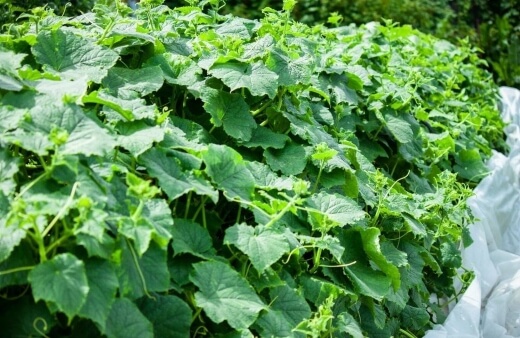
As well as differences in fruit, there are some important differences in growth habits between different cucumber plants. There are three types of cucumber plants;
- Trailing
- Climbing
- Bush
Trailing cucumbers
This cucumbers are most common in the wild, but tricky to grow at home as they either require a LOT of space or a LOT of attention. Trailing cucumbers need at least 2m around each plant as they like to spread out to maximise photosynthesis, and improve the airflow around their low-lying leaves.
If you want to, you can train trailing cucumbers up trellis to save space but will need to tie them in with twine once or twice per week.
Climbing cucumbers
Climbing cucumbers have tendrils that grab onto thin branches, twigs, or trellis very efficiently. They are easy to grow in twine, trellis, or netting and are the most space-efficient cucumber plants.
The downside of climbing cucumbers is that their tendrils take energy away from the plant. The difference is minimal, but like sweet peas or nasturtiums, tendrils take energy that could otherwise be used for flowers (and later, fruit).
Bush cucumbers
This type of cucumbers are easy to grow and need no support. Their domed growing habit makes them ideal for growing in pots and containers where they benefit from isolated nutrients.
Bush cucumbers typically grow to around 2ft tall and spread out 2-3ft. As fruits start to ripen, cut back half the foliage to let light into the fruit.
Best Cucumber Varieties to Grow in Australia
1. Spacemaster Cucumber

Source: sacredplantco.com
Spacemaster is perfect for small gardens and great for growing in pots. This little bush cucumber grows to just over 1 foot tall and has a similar spread.
The fruit is about 8” long but will continue cropping if you pick them up regularly at around 4”. As fruits develop they get larger seed cavities so are best used for slicing, while the younger fruits are great for pickling.
2. Dasher II Cucumber
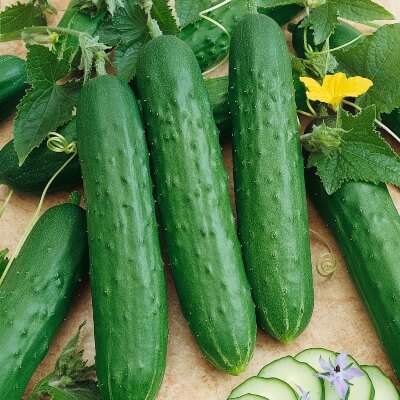
Source: growjoy.com
The short, stubby fruits of Dasher II have a delightfully crisp bite and are perfect in salads, and actually pickle pretty well too. While it’s mostly grown for flavour, it’s also good for growers with regular cucumber disease problems, as it's resistant to powdery mildew, mosaic virus, leaf spot and scab.
And with crops in as little as 55 days it’s a good way to beat the weather-induced problems like downy mildew too.
3. Ashley Cucumber

Source: todfarmslimited.com
Ashely is one of the most prolific heirloom cucumbers, producing shorter, bright green fruit that is ready for picking just 65 days after planting.
It’s one of the few heirloom varieties with genuinely good resistance to downy mildew too, and we’ve never had an issue with powdery mildew either.
Great for growers in more tropical parts of the country.
4. Marketmore 76 Cucumber

Source: kingsseeds.com
Marketmore was developed in 1968, but in 1976 a much-improved version hit the market with much more vigorous growth and open-pollination which gives Marketmore 76 a huge advantage of being really easy to fruit.
The fruits of Marketmore 76 are best picked smaller and have smaller seed cavities than most, making them perfect for slicing or pickling.
5. Cucumber Sugar Crunch
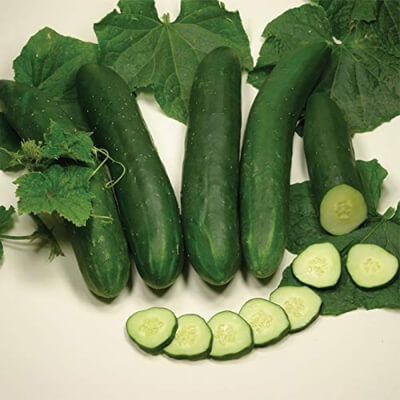
Source: amazon.in
Sugar crunch are super sweet, refreshing cucumbers with a pop of flavour. Best picked at around 3” while the seed cavities are unformed, but they can reach 5-6” if left on the plant to develop.
Their smooth skins mean they produce some of the most boastful-looking pickles.
6. Boston Pickling Cucumber
Source: mygardenlife.com
This heirloom cucumber is an absolutely iconic gherkin, with a tough, bitter, dimpled skin that works perfectly with a basic sweet vinegar pickle.
Boston Pickling is one of the oldest named cultivars still grown today, first bred in 1880 and still loved by gardeners and commercial growers today.
7. Cucumber Burpless #26
Burpless #26 is favoured by show growers thanks to its reliably long, crisp fruits, with a beautifully mild, crisp flavour which is perfect for juicing.
If you want to make an impact in the veggie garden, it’s great for that too, with tall vines that need regular training up trellis, and provide structure and shade for other plants.
8. Sweet Success Cucumber
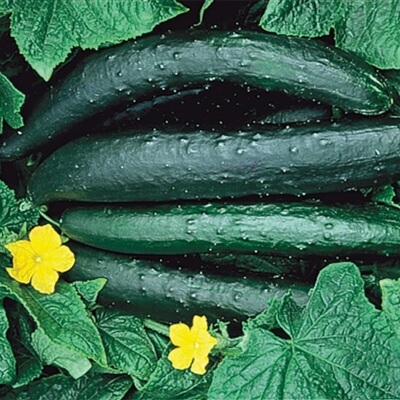
Source: gardensalive.com
Sweet success is a mildly flavoured, seedless hybrid that grows to around 14 inches long on vines that can climb up to 2m in under two months.
If that’s not enough, they are also resistant to scab, powdery mildew, leaf spot, and cucumber mosaic virus making them perfect for growing in any part of Australia.
9. Burpee Pickler Cucumber

Source: amazon.com
The striped fruits of burpee pickler are utterly beautiful, with firm seed capsules which hold their shape when pickled, but also give a wonderful softness to the preserved fruits.
Despite the fruits only growing around 5” long, the climbing plants can reach 2m tall and are ready to harvest in around 55 days.
10. Calypso Cucumber
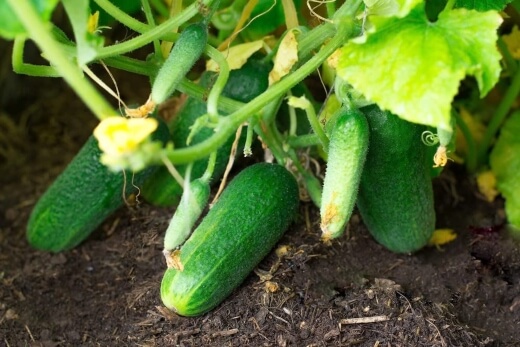
Source: amazon.com
If you’re not afraid of gluts, try growing Calypso. Calypso cucumbers are famous for their high yields and start cropping in around 50 days.
Their spines are soft and can be eaten raw, making a great choice for anyone with limited space who wants to grow pickling cucumbers but still wants the option of slicing for salads.
11. Pick a Bushel Cucumber
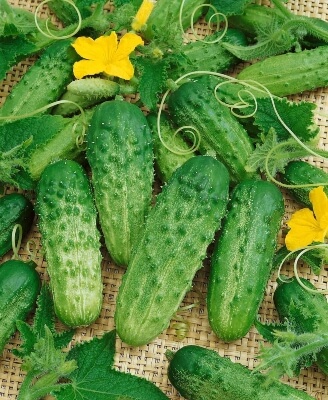
Source: all-americaselections.org
Pick a Bushel is a ‘semi-bush’ cucumber, which sounds complicated but basically just means it needs a little bit of support, rather than a full trellis. They are ready to harvest in around 50 days, so are fast-growing, and will keep cropping for about a month.
Pick a bushel is a great cucumber for growers in Southern Australia as they prefer slightly lower temperatures and can wilt in extreme heat.
12. Cucumber Supremo

Source: gardenseedsandplants.com
Supremo is a great disease-resistant crop that produces a big harvest for its size. Their dark green fruits have pale yellow stripes, and very few spines, making them ideal for snacking and pickling.
Supremo is one of the most widely disease-resistant cucumbers you can grow too, with resistance to nearly all common diseases and infections.
13. National Pickling Cucumber
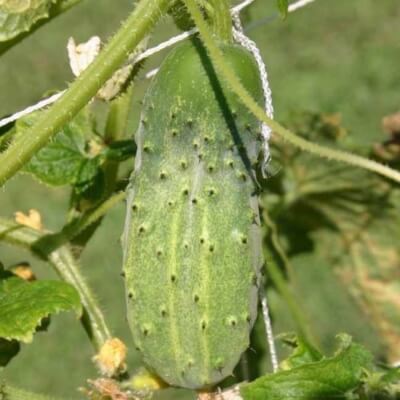
Source: willhiteseed.com
National Pickling cucumbers are often described as multi-use fruits, perfect for slicing and pickling, but in our experience, they are never great for salads, and should always be picked young, as 2-3” fruits and pickled straight away.
Their high yields mean it’s hard to keep up with the plant most years.
14. Sweet Slice Cucumber

Source: totallytomato.com
Sweet Slice are fast-cropping slicing cucumbers that are ready to pick in 50-60 days. Their dark skins wrap a yellowish flesh and large, water-filled seed cavities making them perfect for juicing.
15. Muncher Cucumber
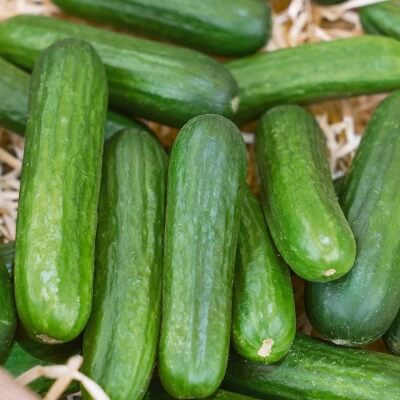
Source: groworganic.com
While late crops can be around nine inches long, Muncher is best picked small at about 4” when it has the best, well, munch. The sweet flesh is wonderful for pickling but best just thrown in your mouth straight off the vine.
How to Grow Cucumbers in Australia
If it’s your first time growing cucumbers, the mixed information online can be pretty confusing, but don’t worry, just take a breath, and stick to your basic instincts. Cucumbers are simple crops that like lots of water and lots of light.
There are some special tricks when it comes to training cucumbers, and feeding them, but as long as their leaves are dry, their roots are moist, and their fruits are warm you can’t go wrong.

Best Conditions for Planting Cucumbers
What Soil to Use
Cucumbers need plenty of organic matter and loose soil that drains at a medium speed. For sandy garden soil, mix in fresh compost, or rotted manure to a 50:50 ratio to help retain water, and improve nutrition.
For clay soils, mix compost, grit, and garden soil in equal parts, or consider building raised beds so cucumbers aren’t sitting in water around their roots.
Sunlight Preference
Cucumbers like warm weather, and plenty of moisture. To help them manage that, give them plenty of light. Cucumbers need a minimum of 8 hours of sunlight per day, but more is better, so find somewhere with good morning sun, right through to late afternoon light if possible.
Cucumber Plant Spacing
Cucumbers need plenty of space regardless of how you plant them. Each plant will spread to a minimum of 2ft, even if trained vertically, so leave at least 2ft between plants.
Below we’ll look at a few different cucumber spacing methods, from rows and hills to trellising.
Planting Cucumbers in Hills
Cucumber hills are a great way of maximising your yield and saving water. They also help to heat the soil, so you can sow directly outdoors earlier in the season.
A cucumber hill is simply mounded compost, with a divot in the centre. The compost hill is quickly warmed by the sun, and the divot in the centre allows you to water without any runoff. Prepare rows of cucumber hills 1m apart.
Each hill should be about 2ft wide, with 2ft between hills in each row. If sowing directly, sow 4 seeds per cucumber hill, and thin to a single cucumber later. If planting young plants, plant just one cucumber per hill.
Planting in Rows
Planting cucumbers in rows is the same as planting in hills. Soil won’t warm as quickly, but cucumbers are less likely to dry out in high summer.
To plant cucumbers in rows, space each row 1m apart, then space cucumbers 0.5-1m apart in each row. This should be the same for any variety, and water is shared between plants, and they will compete if planted closer together.
Growing Cucumbers in Pots
An average 30-40cm pot can accommodate one bush cucumber, 1 trailing cucumber, or two climbing cucumbers. Avoid packing too many cucumbers in.
They can be planted more tightly in containers as they have dedicated compost, and water is more easily retained, but a single cucumber in an average-sized container will produce a higher yield than two or three in the same space.
How to Propagate Cucumbers
Cucumbers are half-hardy annual vegetables, which means they can’t germinate in cold conditions, and can’t be grown from cuttings.
The plants die back completely at the end of the growing season, so the only way to get started is to buy young plants from a garden centre, or sow seeds.
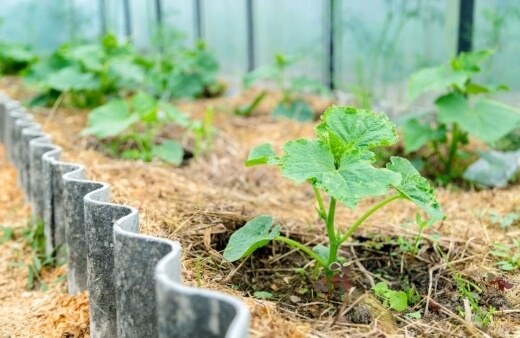
Propagating Cucumbers from Seed
Growing cucumbers from seed requires some basic conditions, and a willingness to lose a few plants. While germination is reliable from packet seeds, each plant will grow at different rates, and they are easily killed by overwatering.
The best way to get around this is to sow several seeds per pot, and remove the weakest plants when they reach 1-2” and have their first true leaves. Follow our step-by-step guide to growing cucumbers below:
You will need:
- 9cm pots (do not sow cucumbers in seed trays as they don’t like to be moved, or have their roots disturbed)
- Garden compost
- Cucumber seeds
- Heated propagator (optional)
Method:
- Fill pots with good quality garden compost. Cucumber seeds need reasonable drainage, and plenty of nutrition as soon as they germinate, so avoid sandy seed compost.
- Leave a 1cm gap between the soil level and the top of the pot to make watering easier.
- Push cucumber 3-4 seeds into each pot, on their sides (there is no right way up) about 2cm deep.
- Water the pots really well to soak the compost.
- Place on a sunny windowsill or in a heated propagator in full sun (cucumbers germinate best when the soil is around 21°C).
- Germination takes 7-14 days.
- Thin seedlings, removing the weakest plants when the first true leaves appear (about 1 week later).
- Water whenever the soil dries out, and plant into the garden when the stem is around 6-8” long, and the roots are fully established in the pot.
NOTE: If direct sowing cucumbers outdoors, sow four seeds in groups (space seeds 2” apart) and leave 0.5-1m between each group. Thin cucumbers when they reach 3-4” tall, and use germinated cucumbers to replace those in groups with no germination.
Caring for Cucumbers
After planting your cucumber, feeding, watering, and pruning are important but fairly intuitive. The only complicated bit is learning how to train them.
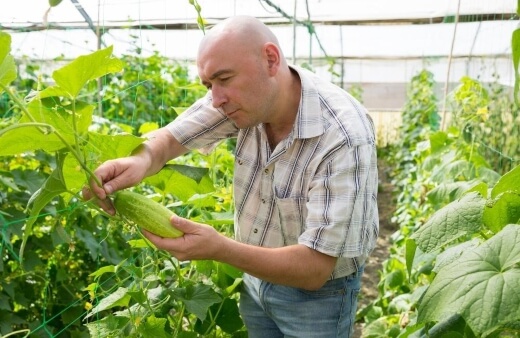
Best Cucumber Fertiliser
Any balanced fertiliser, like liquid seaweed or a basic tomato feed, is adequate for cucumbers. An NPK of 10-10-10, 5-5-5 etc. is ideal, but do try to keep the soil pH slightly acidic if possible.
You can do this with coffee grounds, but most organic fertilisers are just below neutral making them ideal for cucumbers.
Watering Needs
Cucumbers need loads of water. If their soil looks at all dry, water them. As a standard rule of thumb, most cucumber plants should get at least 4L of water per week, raising to 5L when fruits begin to form, but don’t overwater them, and refrain from watering if the soil is still moist from last time.
Pruning Cucumbers
Cucumbers need very little pruning and should be allowed to develop naturally. As fruits begin to ripen, cut away about half of the foliage to let light into the centre of the plant as sunlight helps to ripen them.
For a reliable set of pruning shears, check out our buying guide here.
How to Train Cucumbers

Cucumbers might not need much pruning, but they definitely need training. Unless you’ve got a vast estate with unlimited raised beds, growing trailing cucumbers across the ground is completely impractical, and growing them up trellis helps to avoid misshapen fruit and pest damage.
Training Bush Cucumbers
Bush cucumbers do not need training. They are self-supporting cucumbers with thicker stems that hold their own weight. As fruits ripen, poke four bamboo stakes around each plant, and wrap twine around them.
This prevents the plant from bending under the weight of the fruit.
How to Train Climbing Cucumbers
Climbing cucumbers need trellis, wire, twine, or netting to climb through, but will scramble upwards without any help. Thicker bamboo should be avoided as their tendrils can only grasp material that is 5mm or thinner.
Click here to see our guide for choosing the best garden trellis ideas and kits.
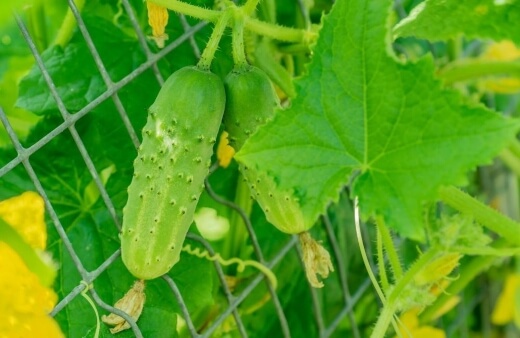
Training Trailing Cucumbers
Trailing cucumber requires a lot of maintenance, but grows better up trellis. The better ventilation of vertically grown cucumbers drastically reduces mildew and fungal problems and helps fruit to ripen more evenly.
To train trailing cucumbers, simply tie them into bamboo, trellis or netting once a week with twine. Don’t tie the twine too tightly as the stems need to expand freely.
Harvesting Cucumbers

Healthy cucumber plants can produce well over 2 kilos of fruit per plant, but will rarely give you a glut. The only cucumber plants that give glut are gherkins, which tend to ripen all at once, leaving you with a lot of pickling to do all in one day.
Most other varieties ripen slowly and steadily throughout summer and into autumn.
When to Harvest Cucumbers
Ripen cucumbers in summer, into early autumn as the fruits start to ripen. Almost all cucumbers taste better and have a crisper bite when picked small, so regularly remove cucumbers when their skins darken.
The longer you leave a cucumber on the plant, the further the seeds inside develop, giving you watery fruits with big seeds that get stuck in your teeth.
Picking regularly encourages further flowering, and further fruit, just like deadheading ornamental plants around the garden.
How to Store Cucumbers
Most Cucumbers have their best flavours when fresh, similar to melons, but with less sugar. But, some cucumbers have high concentrations of cucurbitacin, a bitter compound that is highly concentrated in their skins and settles through cooking or pickling.
Fresh cucumbers keep for around two weeks in the fridge on kitchen paper but are at their best for the first 5-6 days. If you want to store cucumbers for later in the year there are a few great tricks to keep your harvest going for longer.
Pickling Cucumbers
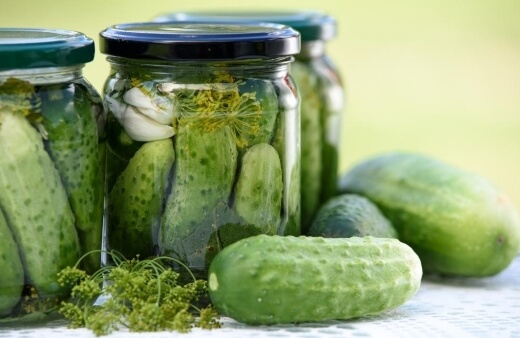
Gherkins and pickling cucumbers are the best varieties for pickling, but if you end up with a glut of slicing cucumbers or burpless varieties they make pretty good pickles too.
Basic pickle recipes are simple, just bring white vinegar and your chosen spices to a simmer, with sugar (to taste) and pour over sliced cucumbers in a sterilised jar.
For a stronger tasting pickle, briefly add your sliced cucumbers to the simmering liquid before adding to jars (they will lose their crunch, but be packed with sharp flavour).
Freezing Cucumbers
Cucumbers freeze terribly. There is no way to freeze fresh cucumbers without them turning to mush when defrosted. However, this year we tried something new and it’s going to be part of our preserves forever.
Rather than freezing whole cucumbers, juice them, and freeze them in ice cube trays to add to drinks. They impart a super-stronger cucumber flavour to chilled water, with a spring or two of mint, and will keep indefinitely.
A great twist on this is to mix cucumber juice with prosecco or a splash of gin in the freezer. The alcohol won’t freeze fully so you’ll get gloriously refreshing alcoholic slushies.
Possible Cucumber Pests and Diseases to Look Out For
For all of their positives, cucumbers have one rather large set of negatives… They are very susceptible to pests and diseases. Like any water-hungry plant, they require a fine balance of moisture, humidity, light, and heat to maintain healthy growth, and getting that balance wrong can lead to a swathe of problems.
Below, we’ll look at the common cucumber growing problems, and how to prevent pests and diseases on your prized cucumbers.
Aphids
There are literally thousands of species of aphid, and all of them will congregate on cucumber plants. Their eggs live in the soil over winter and develop into larvae that climb that plant in spring.
As plants develop the larva grows into wingless adult females which reproduce by cloning and egg laying. They are generally pale, creamy white, but there are many black and green forms.
Infestations cover growing tips and young leaves in a sticky substance called honeydew, which raises humidity and causes fungal infection. Encouraging ladybugs and wasps in the garden keeps populations down, and organic insecticides like neem oil are fast-acting treatments.
Cabbage Looper Caterpillar
Cabbage looper moths lay their eggs on the underside of young cucumber leaves. Their caterpillars can eat entire leaves in under a day, and grow quickly into the cocoon stage, before developing into adult moths.
Cabbage looper caterpillars are bright green, with yellow stripes on either side of their body, so are well disguised. Check any partially eaten leaves and remove the caterpillars by hand. Either move them to another part of the garden or feed them to birds.
Cucumber Beetles
There are three distinct species of cucumber beetle, all about 5mm long. The Striped cucumber beetle has a yellow thorax and its back has alternating black and yellow stripes.
Insecticides can help, but the most effective way to prevent them is to net cucumber plants until they start to flower. Remove any netting when flowering starts to allow bees and pollinators access to the flowers.
Cutworms
Cutworms are the large brown caterpillars of the Nephelodes minians moth. The moths are brown and patterned to blend in with the bark of trees.
Protect young cucumber plants by netting them in spring, and removing the netting in summer to allow pollinators access to the plant. Remove caterpillars from damaged leaves and put them on the bird table.
Flea Beetles
Flea beetles can devastate crops, and attack everything including potatoes, tomatoes and cucumbers. Early signs of damage are small holes across entire leaves, in no certain pattern.
Later, entire leaves will be completely eaten, leaving a skeleton behind. Flea beetles are tiny, 1-2mm beetles that are very hard to spot, but large infestations will be visible as clusters of tiny brown insects.
Scrape off any visible flea beetles and treat cucumbers with neem oil to prevent further infestations.
Stink Bugs / Shield Bugs
Shield bugs, or stink bugs, are beautiful beetles, with shield-shaped backs. While they look wonderful, they have a voracious appetite and love the Cucurbitaceae family.
They are incredibly common insects, so basically impossible to keep out of the garden, but you can prevent severe infestations by keeping your growing area tidy.
Shield beetles overwinter, and spend evenings in weeds and scrub, and like to hide on the underside of deciduous foliage, so remove any weeds from the growing area, and plant cucumbers away from established shrubs.
Refer to our guide and let Nathan walk you through the right way to get rid of stink bugs.
Thrips
Large populations of thrips cause significant deformities in young leaves on cucumbers, leading to a silver, sticky secretion all over the surface. Their small black droppings stick to the leaves and put off predators.
If you notice small black droppings on cucumber leaves, wash the leaves, and predatory insects will quickly come in and eat any remaining thrips.

Downy Mildew
Downy mildew, as the name suggests, creates a downy layer of fungal spores across the surface of cucumber leaves, attaching to the small hairs on each leaf.
The underside of leaves will have fluffy, purple patches, often covering the entire leaf, while the surface will show uneven yellow patches, with reddish brown marks in the centre.
Downy mildew is spread by wind, rain, and insects, but will only take hold on plants with wet foliage in warm conditions. Avoid watering cucumber leaves at all times to avoid downy mildew.
Powdery Mildew
Powdery mildew is the most common problem on all cucumbers, squashes, melons and gourds. Early signs are hard to spot, but as it develops, patches of powdery white film will spread across the surface of leaves, covering the entire leaf within a few days.
Powdery mildew is spread by wind and attached to damp foliage. Treat with an organic fungicide, and remove badly affected leaves.
Cucumber Mosaic Virus
Also called squash mosaic virus, cucumber mosaic virus spreads through the cells of the plant, creating vivid mosaic patterns which spread evenly and symmetrically across each leaf.
Cucumber mosaic virus can affect fruit as well as foliage. Key to preventing mosaic virus is preventing aphids. Aphids are the most common cause of cucumber mosaic virus, so treat aphids when you see them, and plant aphid repellent plants.
Treat with organic fungicides, like neem oil or horticultural soap, which will also kill any remaining aphids.
Anthracnose
Anthracnose can affect the leaves, fruit, and stems of cucumber plants. It is a fungal infection that causes brown circular lesions that start on foliage and spread to the rest of the plant.
As it develops the lesions become hollow and rot. Treat with a fungicide, and burn any affected material.
Gummy Stem Blight
Gummy stem blight is hard to treat, but not very common in well-cared-for cucumber plants. Signs include greenish pale grey lesions between the main veins of leaves, and stretching around the leaf margins.
Often the leaf will only show signs on one side. The stem will be spongy, grey and look as though it has been stripped bare, with a fluffy powder on the surface.
Carefully remove any affected growth. Cucumbers with gummy stem blight may still crop, but you should remove any signs of infection and burn them, and wait three years before planting in the same spot.
Alternaria Leaf Spot
Alternaria is a form of blight, a fungal infection that enters leaves through damage caused by pests in humid conditions. If you notice orange spots all over cucumber leaves, it is usually Alternaria.
The orange spots eventually grow and meet up, creating brown blotches, with yellow rings around them. Remove affected leaves and burn them as soon as you notice Alternaria blight.
To prevent it from happening, avoid watering the leaves, and target water at the base of the plant.
Cercospora Leaf Spot
Cercospora is a dark leaf spot, caused by Cercospora citrullina. The underside of leaves have small bright-orange spots, which correlate to dark brown, or black lesions on the surface of the leaf.
The fungus lives in soil and compost for over 12 months, so destroy any affected plants, and do not plant cucumbers in the same spot for at least three years.
Fusarium Wilt
Cucumber wilt (also called Foot-Rot, or fusarium wilt) usually affects young plants and seedlings. Stems will have brown lesions up one side of the stem, from the soil level upwards.
To prevent fusarium wilt, treat seeds with fungicide, use clean compost and practice 3-4 year crop rotations.
Cucumbers Frequently Asked Questions

How long do cucumbers take to grow?
Cucumbers germinate in 7-14 days, and are usually ready to plant out about 3-4 weeks after germination when the foliage has fully developed and stems are about a pencil’s width. Once out in the garden, cucumbers ripen in around 60 days.
How many cucumbers will one plant produce?
A healthy slicing cucumber can produce at least ten cucumbers, but usually, more in a good growing season, while gherkins can produce well over 30 fruits in a good year.
Feed your cucumbers regularly, and harvest fruits as they ripen to get longer-lasting yields.
What should you not plant near cucumbers?
Melons and other squashes don’t do well near cucumbers. They compete heavily for light and nutrients and share many common diseases.
It’s also worth keeping potatoes, tomatoes and peppers away from cucumbers as several fungal diseases spread between these plants.
What grows well with cucumbers?
There are plenty of great companion plants to grow with cucumbers. Nasturtiums help to deter pests like aphids and don’t use much moisture. Plus, the peppery leaves of nasturtiums are a great accompaniment to cucumbers in salads.
Have Fun Growing Different Types of Cucumbers in Your Backyard
Cucumbers should be a regular in any veggie garden. Growing cucumbers is intuitive and simple to get started with for beginners to gardening or vegetable growing, but also has some simple challenges that help to introduce you to many common pests and diseases.
Plus, if you’re already familiar with how to grow cucumbers, there’s always more to learn. Try experimenting this year with trailing varieties grown-up netting, or just have some fun with preserves to keep your harvest going for longer.
Published on August 5, 2022 by Maisie Blevins
Last Updated on February 22, 2024

